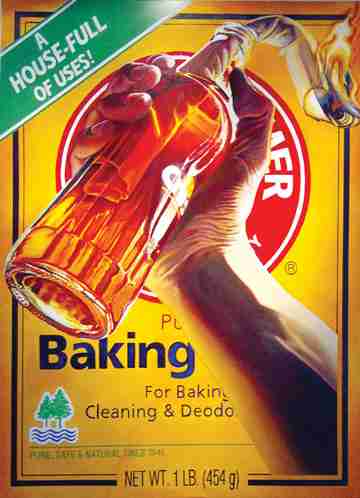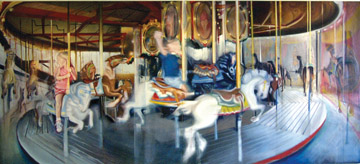The Aura of Commercial Americana

Harm and Hammer, another explosive oil on canvas by Jason Chase.
March 5, 2004
For a taste of nostalgia tinged with dark humor, one should drop in the Harbor Art Gallery to see Jason Chase’s visions of suburban America in “Stars and Strip Malls.” Using bold, bright splashes of color to repeat the motifs of commercial America from the 1940s to the 1960s, we get a somewhat darker and more cynical view of that time.
One particular piece I loved was Katie’s Gummie’s, apolitical in scope, but fun and vibrant. With layer upon layer of translucent, brilliantly colored gummy bears, the painting seems so realistic that viewers should restrain themselves from trying to lick the canvas.
However, Harm & Hammer doesn’t try to be nearly as cute. At first glance, the image appears to be a hand holding an old-fashioned glass soda bottle, in this case orange Crush, in front of a perfectly innocuous looking advertisement for Arm & Hammer Baking Soda. It’s the burning, soaked rag pouring out of the mouth of the bottle that tips the viewer off to the fact that it is, indeed, a Molotov cocktail. This gives a darker cant to the slogan above, “A house-full of uses!”
One gets the same feeling from the piece Super Bang featuring what looks like an upside-down light bulb but is actually a bomb, complete with 48 shots. The most disturbing part is not the picture but that the subject matter is actually a mock-up of a child’s toy.
Others are more subtle, describing typical suburban settings, such as the parking lot in Suburban Landscape. This panoramic picture features a strip mall dominating the background while a large SUV sits in the foreground. It’s one of the pieces that is easier on the mind, showing an idealized version of normalcy: nearly cloudless blue skies in a sunny and pristine setting.
In his artist’s statement, Chase explains the commercial slant in his work, “Some of my earliest visual memories are the colors of the cereal aisle flashing by me. Constant exposure to advertising slogans and Saturday morning cartoons not only sold me products, it sold me the power of the visual. It started an appetite that I still have for bright, flashy, bold images that are familiar to anyone in reach for American consumerism.”
Carnival shows a merry-go-round whirring by in a blur of motion. A little girl looks back, almost in fright it seems, shouting, while a little boy looks ahead, waving his hands in the air in excitement. The shadowy images of the horses are eerily mirrored outside the spatial reality of the merry-go-round. Each of Chase’s scenes appears to have a second meaning if the viewer looks long enough.
Chase takes on the spectre of middle America by making his logos and bubbly motifs larger than life. In blowing up his visions of fantasy, he mocks the very perfection that advertisers are always trying to push on an avid, gullible populace.
“Because the images I use have so completely saturated our lives, I want everyone who sees my paintings to relate to them, to be engaged by art and to contemplate the world they live in.”
“Stars and Stripmalls” will be on display until March 24 in the Harbor Art Gallery.
























































